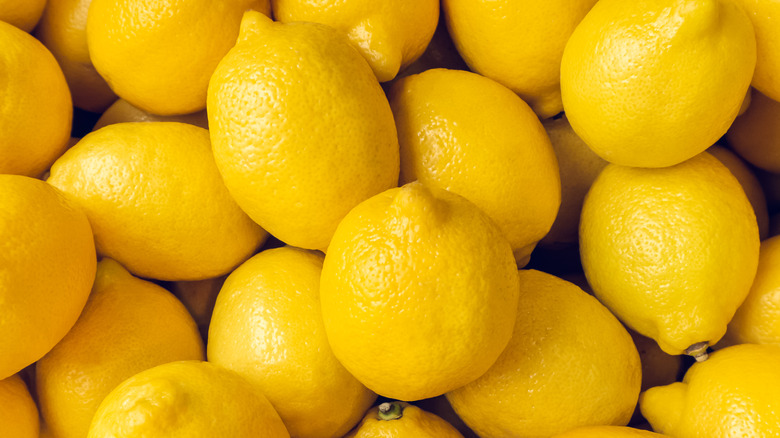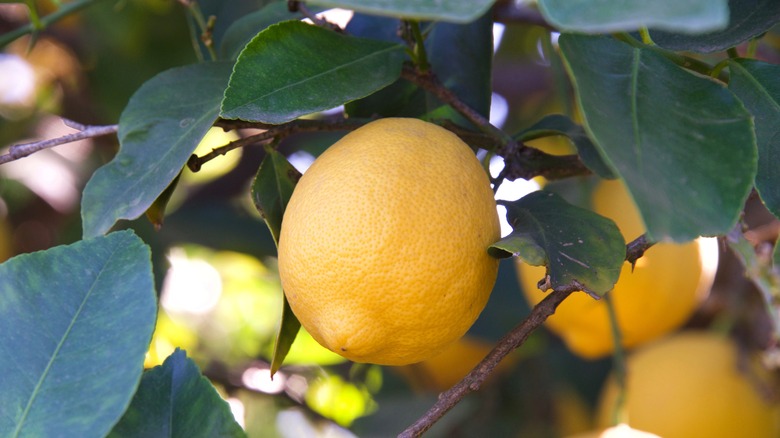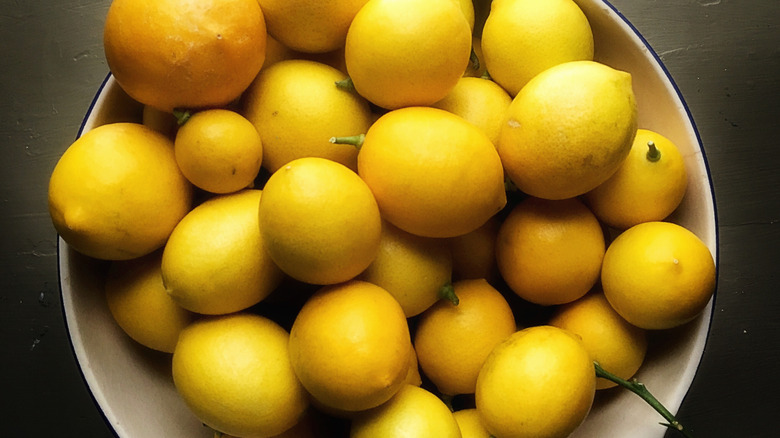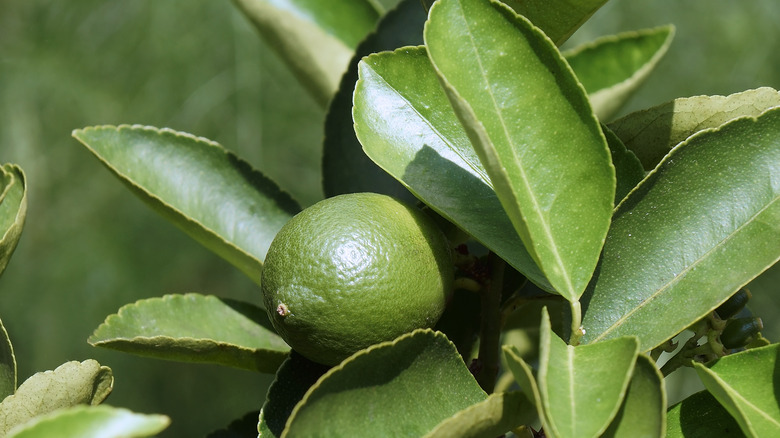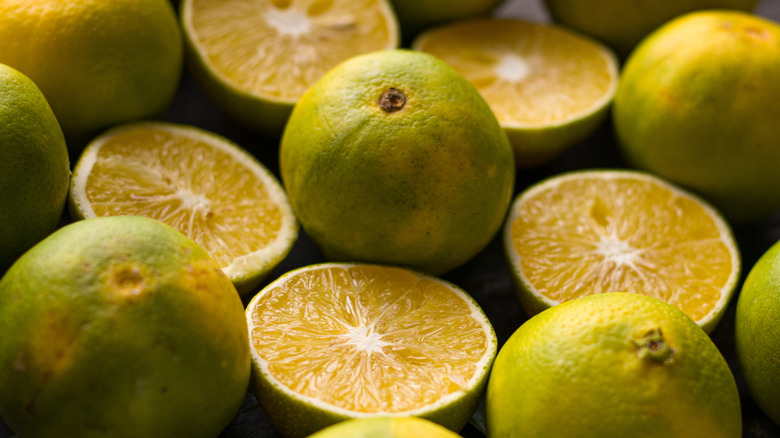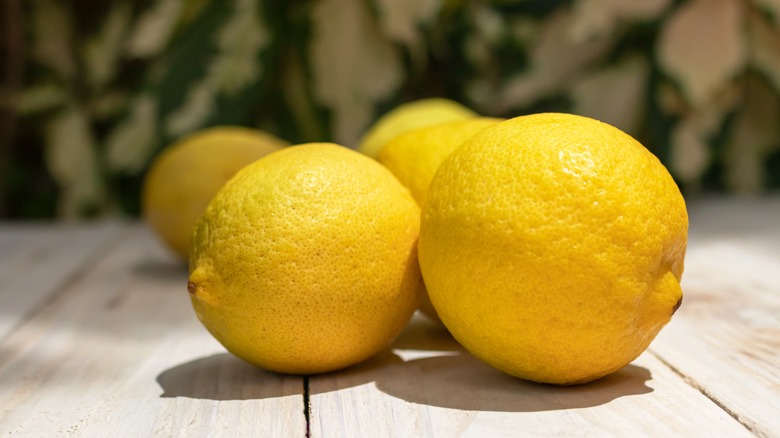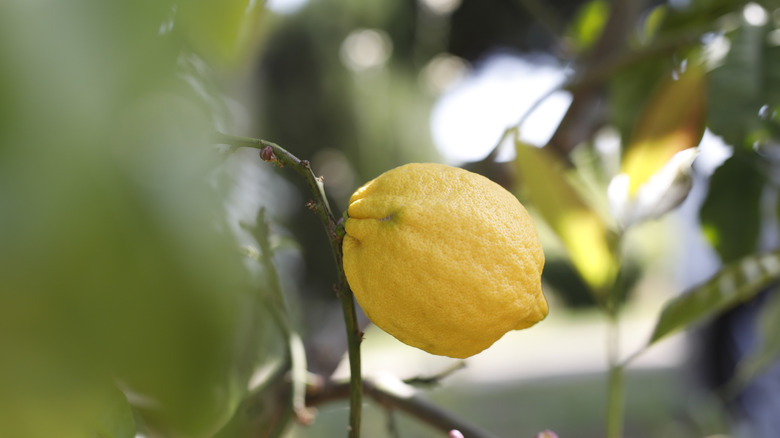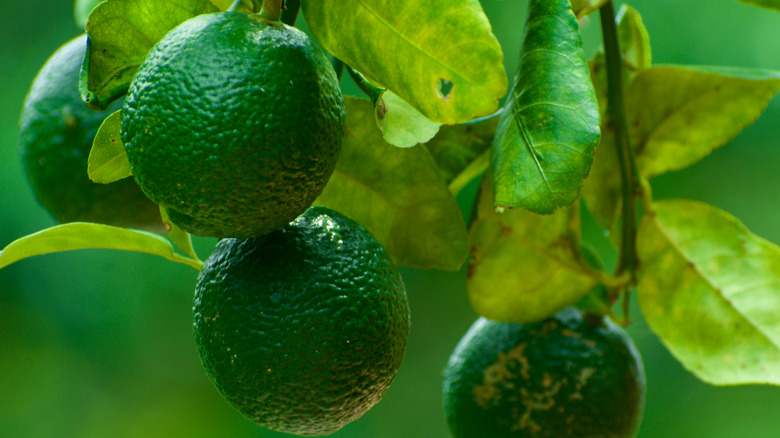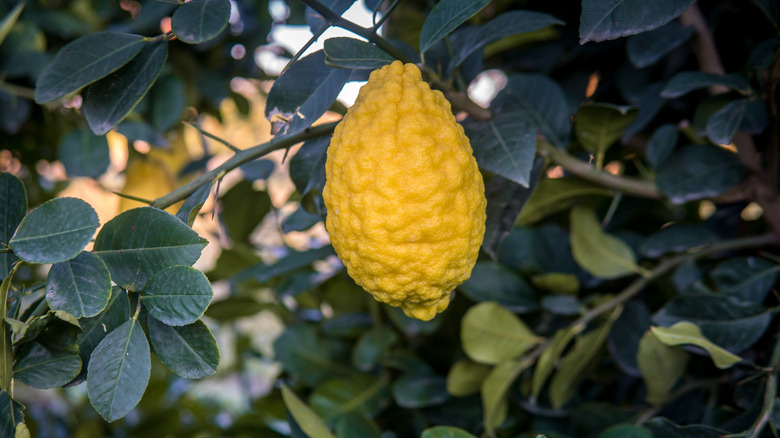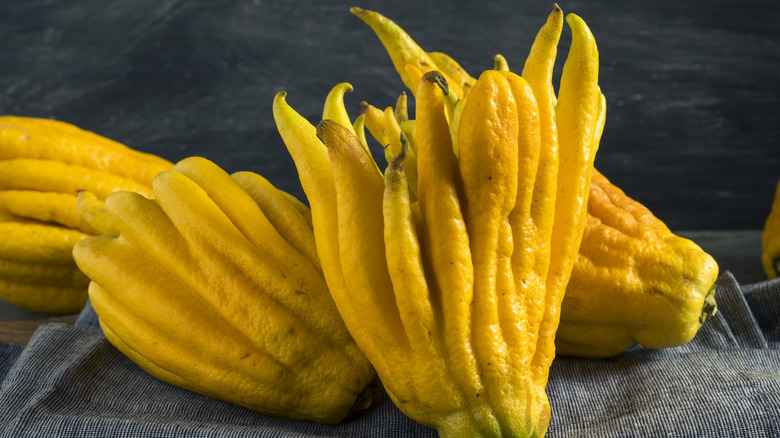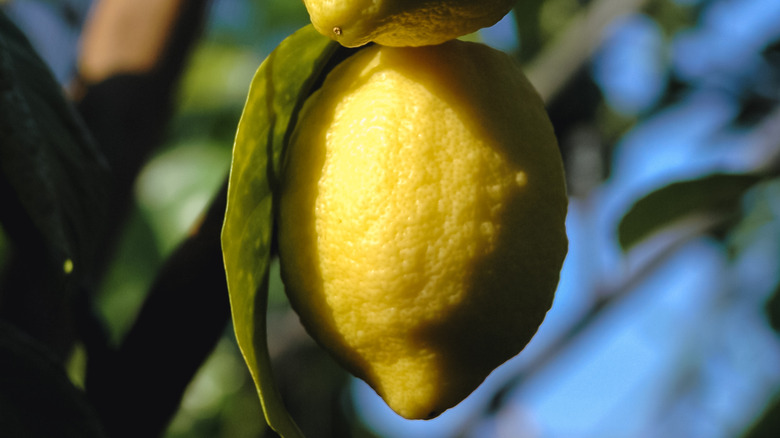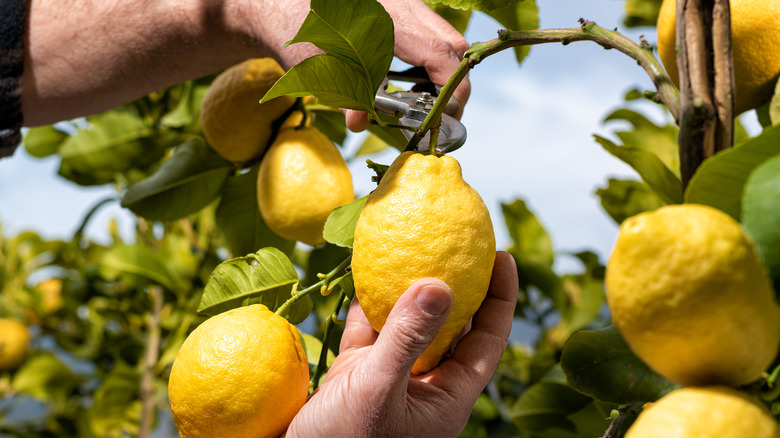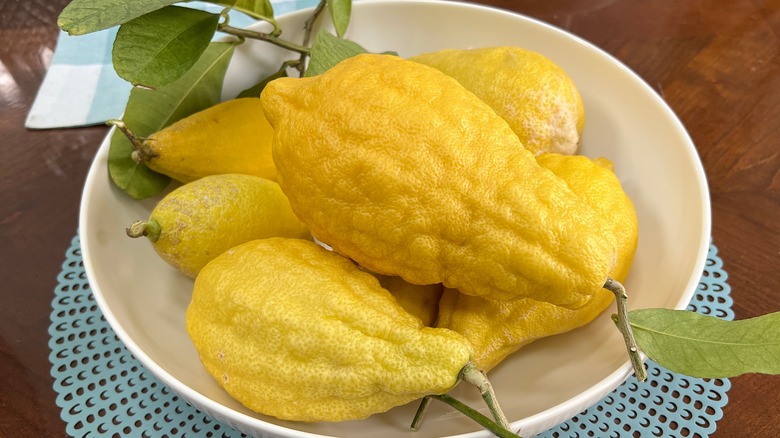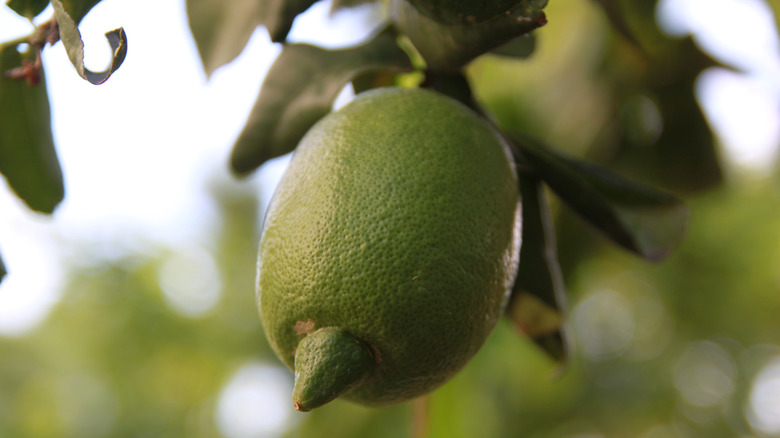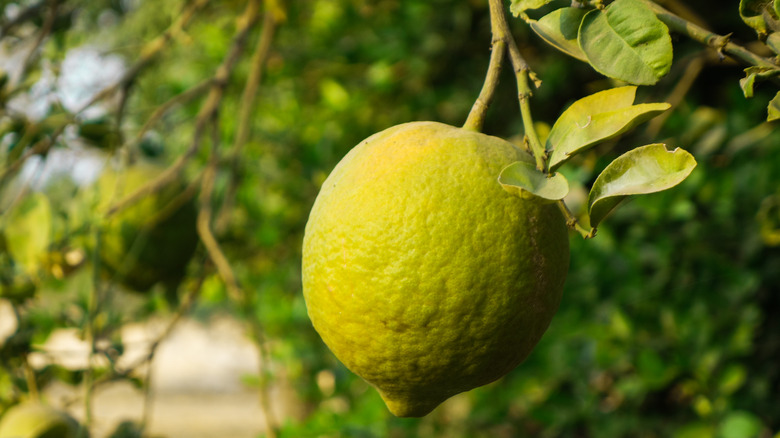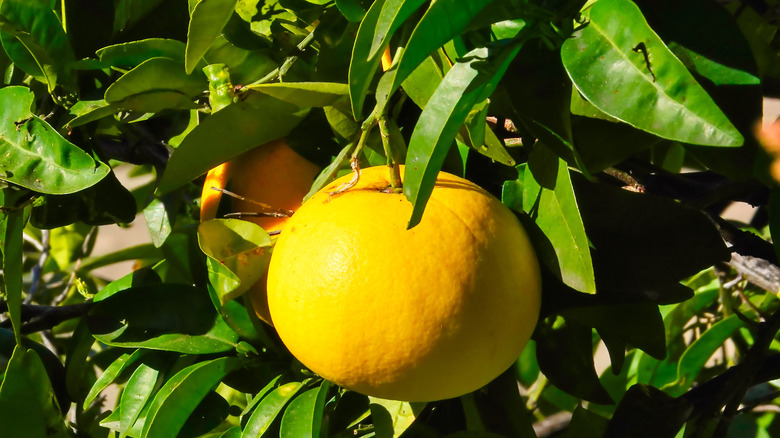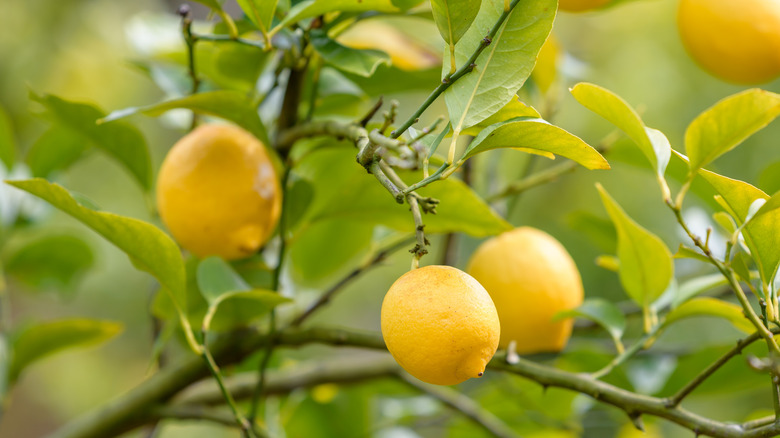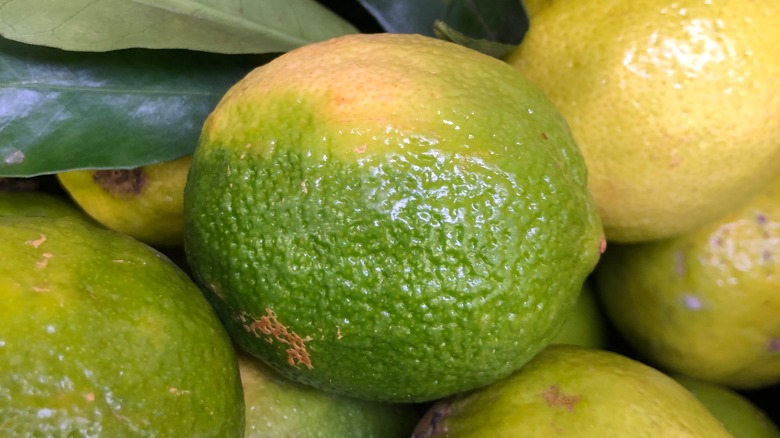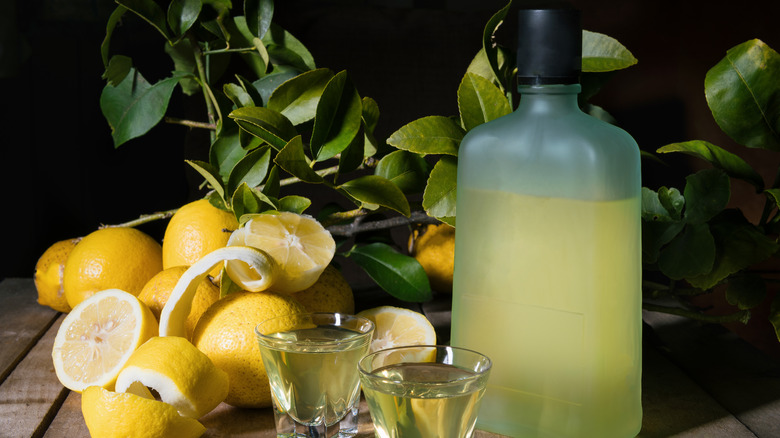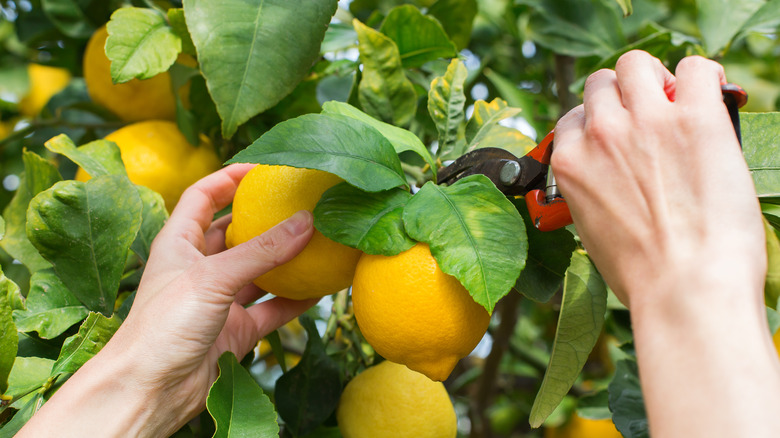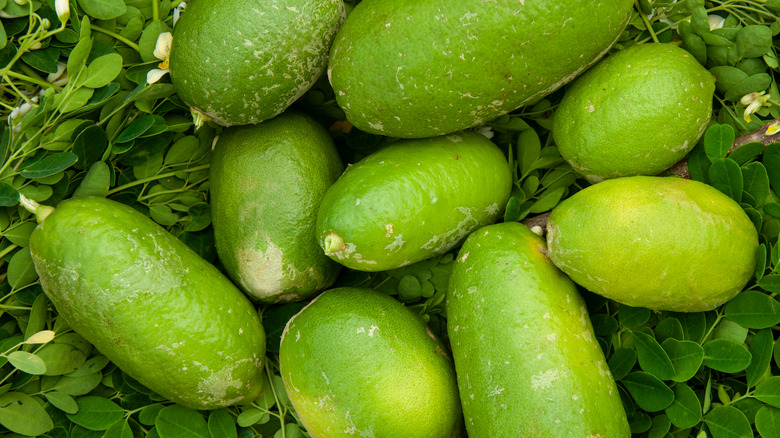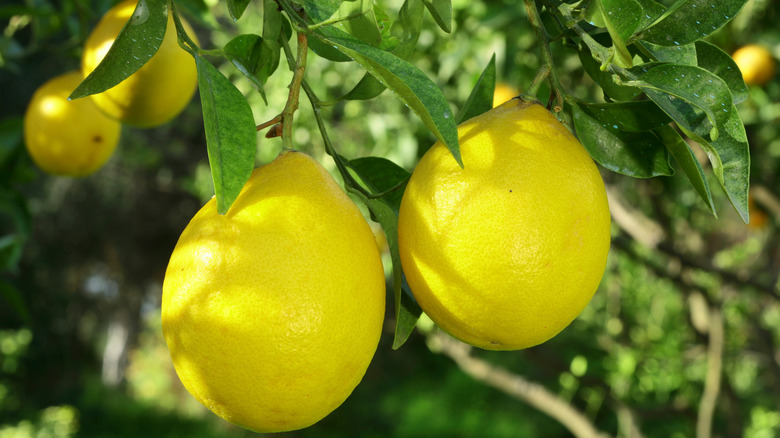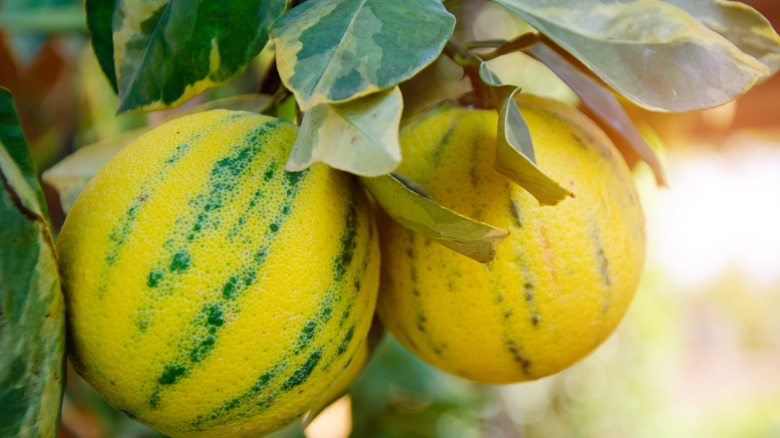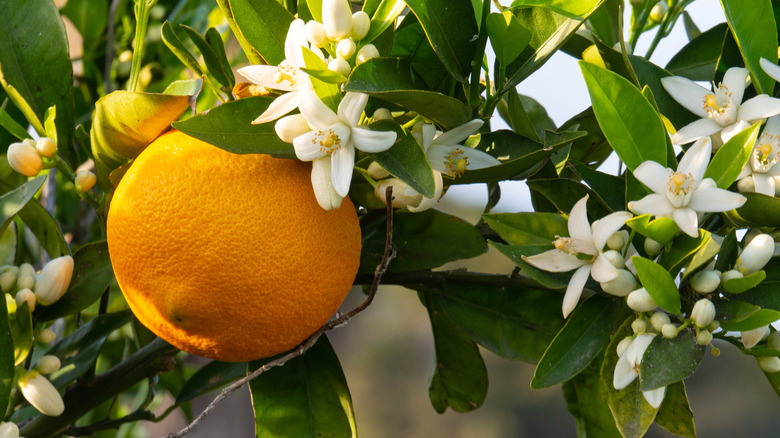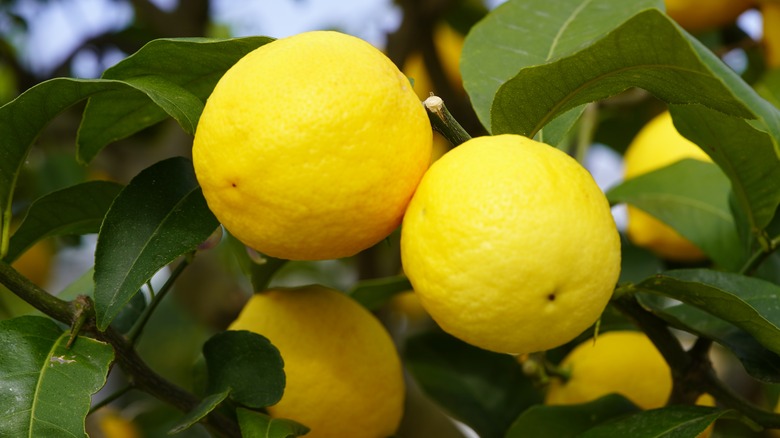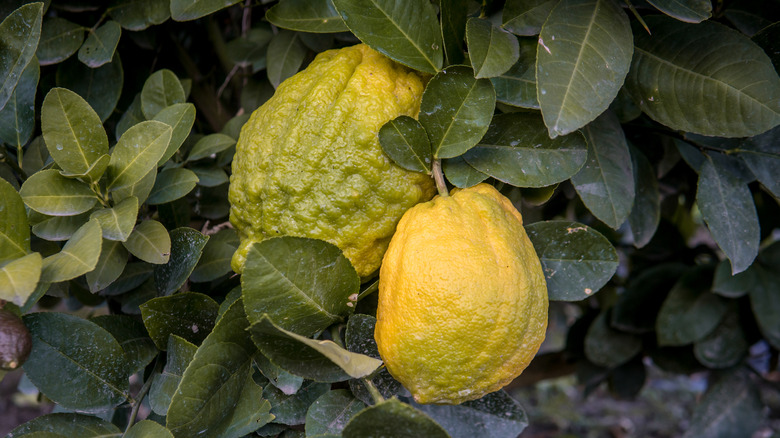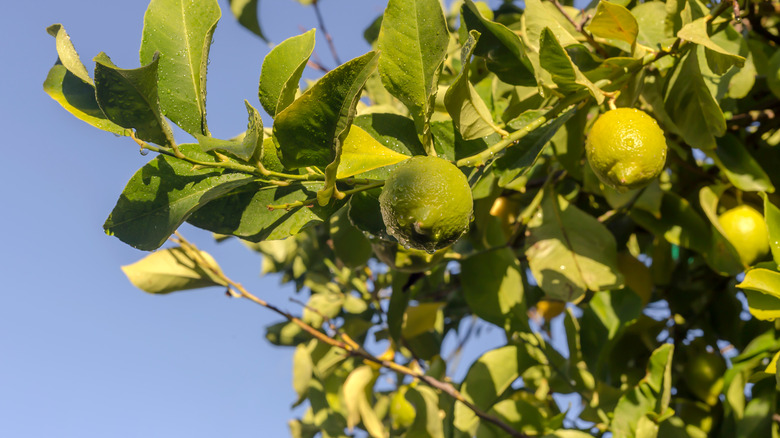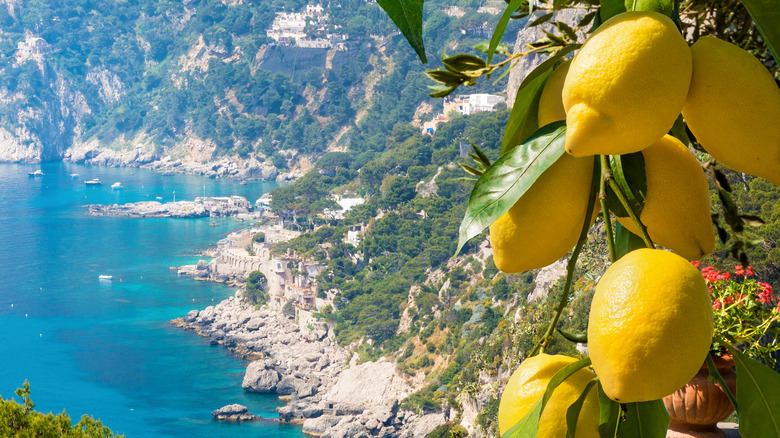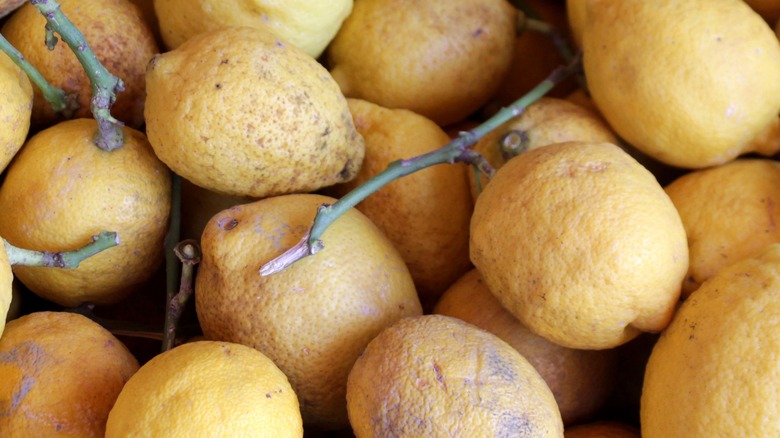31 Types Of Lemons And What Makes Them Unique
We love lemons. And anyone who enjoys cooking or cares about flavor should as well. There's nothing quite like that final squeeze of a lemon over your salad, baked desserts like a lemon bar, or zested over fish. This sweet yet sour, bright fruit is the key to turning a regular dish into something spectacular. In fact, we've compiled an online collection of all our citrus recipes.
But did you know there are dozens of types of lemons? We may only come into contact with two or three varieties on a daily basis, but once you learn about each lemon, you'll want to track them down to try for yourself. Some are accessible to grow inside or outside of your home, while others can be tracked down through international grocery stores or local farmers' markets.
Some of these lemons are hybrids with other lemons, limes, or oranges. But citrus is citrus, and we enjoy it in almost everything.
Lisbon lemon
Starting off easy with the lemons we see piled high into pyramids at every grocery store: Lisbon lemons. These are what many of us think of as being the only lemon, or at least the most common one. It's basic and all-purpose — what more could you want? According to Minneopa Orchards, the Lisbon lemon tree descended from Portugal before moving to Australia and was then introduced to farmers in California in 1950.
The Lisbon lemon is tart but not overly so, with a thin skin that makes it easy to peel and squeeze over dishes or desserts. It also means Lisbon lemons are easy to zest. However, because the rind is so thin, there are fewer essential oils packed into the pores as compared to other lemon varieties.
Lisbon lemons also aren't impossible to grow in diverse climates. They're not super cold-hardy but are relatively moderate in size. Meaning that you can easily plant the tree into a large pot and wheel it in and out of your house (or apartment) in the winter (via SF Gate).
Eureka lemon
Eureka lemons are pretty interchangeable with Lisbon lemons, so they may be easily available at your local grocery store or farmers' market. When it comes to telling the two apart, Eureka lemons have a thicker skin that makes them better for providing zest in recipes. Monrovia writes that Eureka lemons also produce fruit year-round (which we love because the more lemons, the merrier). The flower color is white and the oblong leaves a deep green hue. But what sets Eureka lemons apart is the bronze-purple new growth they feature.
The lemons themselves are medium-to-large in size with bulbous, rounded ends at each side (via Specialty Produce). Eureka lemons can sometimes be seedless, which is a major perk for cooking with them, and they have an incredibly aromatic oil.
Meyer lemon
Perhaps the second most known lemon would be the Meyer lemon, which is technically a hybrid fruit and not a "true" lemon. Meyer lemons originated in China, according to NPR, where they were primarily used as a house plant. Now they're typically thought of concurrently with citrus-based desserts — like this Meyer lemon souffle or a Meyer lemon custard cake — thanks to them being on the sweeter side.
Meyer lemons can also be used in marinades, sauces, and in any dish where you want to add brightness. The skin on these lemons is thinner than most and entirely edible — just imagine cutting thin slices of lemon and tossing them into your mouth like chips. You could do it. But, you probably won't. You can enjoy the full lemon instead by slicing and dicing however you please and roasting the fruits with root vegetables and proteins. However you decide to enjoy Meyer lemons, the result will be balanced and bright.
Bearss lemon
No, this is not a typo, Bearss lemons do have two "s's" in the name and are a real thing. They first originated in Italy but now grow across Europe, and they are slightly larger than a Lisbon lemon so it has more juice and skin to zest (saying "skin" just sounds wrong here, right?). If a Meyer lemon is too sweet for you, then a Bearss lemon might be a perfect choice. It's tart, and, according to Citrus.com, has more juice than other lemons its size.
Bearss lemons also have more oils in their skin — probably a result of them being larger — which makes the resulting zest more flavorful and aromatic. For instance, if your recipe calls for massaging lemon zest into the sugar to release the oils, going for a Bearss lemon would make that easier. Minneopa Orchards notes that Bearss lemons are often mixed into pastries, cakes, pies, and also into bread.
Limetta lemon
Perhaps unsurprisingly given its name, Limetta lemons are sometimes green in color (via Citrus Variety Collection). Limetta lemons can also have very low acidity levels depending on which variety you get, so they are often also referred to as sweet lemons. If you're looking to distinguish a Limetta lemon from a "true" lemon like a Lisbon, focus on the leaves. The first will have leaves that are a bit oval with pointed ends, versus the latter which is primarily oblong.
As for their level of acidity, the Millsweet Limetta lemon is, well, sweet. Root Simple writes that beyond the Limetta color, these lemons also get their name from exhibiting those sweeter lime flavors. Most importantly, Limetta describes a type of lemon, of which there are multiple varieties. Some are sweeter than others, and some are tart like a traditional lemon. Whichever you get depends on where you are and what you have access to. But it's worth experimenting with.
Fino Citron lemon or Primofiori lemon
A lemon by many (okay, two) names, the Fino Citron lemon, or the Primofiori lemon, is believed to have originated in Spain before moving around the world and landing in Australia (via Citrus Australia). The Fino Citron lemon can grow in the winter and has a low seed number with an average of five seeds per fruit. Australia imported the Fino Citron lemon with the hope of obtaining a lemon that could grow between September and mid-November.
Beyond its relative cold-hardiness and shockingly little number of seeds, the Fino Citron lemon has a higher juice content and acidity. In fact, some — including World Foods and Flavors — write of it as being highly intense. Ironically, this makes the Fino Citron lemon perfect for sweeter treats and lemonades that will already be offset by an immodest amount of sugar. You can also use Fino lemons in food preservation, as that high acidity works as acidification.
Yen Ben lemon
Rigorously grown in various places including California and Australia, the Yen Ben lemon has a smooth rind to it and a high juice content. If we're going just by the look of the fruit, then not much seems different. Both the Lisbon lemon and Yen Ben lemon are oblong with short tapered ends with a vibrant yellow color to them that is simply unmistakable. Where things get different is the Yen Ben lemon tree. Perhaps because the trees are precocious, according to Citrus Variety, they look more bush-like when laden down with lemons. The leaves also appear darker in color and a bit thicker than the typical lemon tree.
The Yen Ben's high juice content and the smooth rind are appealing. And unlike most lemons which harden and lose their juice over time, Citrus Australia writes that the juice of Yen Ben lemons can be maintained with proper long-term storage. This lemon is also incredibly low in seeds, with an average of two per fruit – amazing.
Verna lemon
Verna lemons may have a distinctive sour taste, but they are often seen as similar to Lisbon lemons. However, if you take one quick look at any photo, you'll notice they seem a bit wider than a Lisbon. Verna lemons are of a Spanish variety and highly antioxidant, as most lemons are (via Campos de Azahar).
The tree is durable and the fruit is fluorescent against its dark green leaves. What makes the Verna lemon so wonderful is its long growing period. According to Snature Fruits, the first harvest flourishes in spring, but the fruit can be picked long into July before the second harvest begins in August and ends in September.
Verna lemons are highly appreciated for their large juice content of around 30% to 40%, writes Gardening On. They are also low in acidity and seed count, which makes them a great addition to juices and the occasional lemon water. Some Verna lemons can have thinner skin than others, so it's worth doing your own research as well based on your personal preferences!
Kagzi lemon
Kagzi lemons are smaller in size and often harvested while the skin is still green, which means they're often mistaken for limes. But Kagzi lemons are actually lemons and ripen into a gorgeous light yellow color (via Shrigram Organics). This lemon is incredibly popular in India, with an impressive number of websites that sell Kagzi lemons or provide information. According to Aranyaani Food Forest, Kagzi lemons are in high demand in India because of their nutritional and medicinal value, as well as being relatively low in price. The tree is also easy to care for with a high fruit yield. Kagzi lemon plants require full sun exposure and well-drained soil to thrive.
The lemon itself can be used as a digestive aid, and apparently, the juice helps to relieve mosquito bites (which we'll definitely be testing this summer). When eaten, the Kagzi lemon has a sour, slightly bitter taste that still has some hints of sweetness to it.
Bush lemon
Now, these look a bit wild. Sure, it's interesting to read about similarly-looking lemons and their minute differences, but where things get really fun is with varieties like these Bush lemons. They're bumpy with thick skin and can look more orange than yellow, depending on the variety. They just look fun.
But beyond that, Bush lemons have an iconic citrus taste — just not much of it, thanks to a low juice content. Gardening Know How explains that Bush lemons are actually the preferred lemon used in Australian lemon butter, which is more like a curd than butter (but delicious nonetheless). These lemons, despite their possible off-putting outside appearance, are completely edible and should be enjoyed! As are the leaves, which make a delicious tea.
Bush lemon trees are easy as long as you live in a frost-free zone. However, finding information about Bush lemons can be a bit tricky, as the internet thinks you're simply talking about lemons that grow on a bush. Bush lemons are actually from Australia and grow on a small tree with fragrant white flowers.
Buddha's hand lemon
If you've been paying attention at grocery stores and farmers' markets, you might have seen Buddha's hand lemons popping up more and more. But how do you use one? Lucky for us, the Smithsonian Magazine has been wondering the same thing. If you cut into the fruit, you'll notice there's only white pith; there's no possible way to juice this thing.
According to the Smithsonian Magazine, there are at least six varieties of the Buddha's hand lemon. While this lemon doesn't have any pulp, it does have an incredibly aromatic skin and zest. Because of this, the Buddha's hand lemon makes a fantastic addition to cocktails. You can either add the rind as a garnish or make your very own Buddha's hand-infused spirit. The lemon rind can also be candied, or simply as zest on desserts thanks to it being sweet and not bitter.
Villafranca lemon
Villafranca lemons are similar to a Lisbon lemon in crop distribution and are hard to distinguish from the Eureka variety simply in looks (via Citrus Variety Collection). They are said to have originated in Sicily but don't get much love thanks to being not that special in comparison to our most recognizable lemons. However, according to Oscar Tintori, Villafranca lemon trees have fewer thorns, which is appreciated when picking.
Before we let Villafranca lemons pass back into the shadows, let's give them their well-deserved spotlight by saying what makes the Villafranca lemon stand apart is its use in a delicious Italian liqueur. Four Winds Growers writes that because of the Villafranca's high oil content, they're a better option when making limoncello. Since the recipe is basically only water, vodka, sugar, and lemons, having good quality lemons high in essential oil and juice makes the whole process easier and more delicious.
Baboon lemon
Again, this is not a made-up name. Baboon lemons come from Brazil and are noticeably large — about the size of your hand — with an intense rind and flesh. According to Harris Citrus Nursery, Baboon lemons are acidic with a slight lime taste.
They seem to be a popular variety to grow inside, with one gardener writing into Houzz, an online forum for all things home, about her harvest. She felt the Baboon lemon was like the Ponderosa lemon in looks, while the flavor of the lemon was entirely unique. Sweet and sour like all lemons, but apparently more floral than a typical lemon. Baboon lemons have a high juice content (thanks to being ginormous), but their thick rind makes them hard to squeeze (via Lemon Citrus Tree). If you're looking to grow your own lemon trees but want something a bit more unusual, it seems like Baboon lemons might be the way to go!
Citron lemon
Another bumpy variety! But that's not the only thing cool about them. Citron lemons are also the oldest known lemon variety (via Arte Cibo). We most likely have the Jewish people to thank for transporting them from Syria to Spain — though there are different types of citron fruits all over the world.
Citron lemons have a thick rind with gorgeous lumps running across it — almost like what certain gourds look like in the fall. Inside, they're not dissimilar to the Buddha's hand lemon in that there's very little flesh. And what flesh there is tends to be dry. So this lemon/citron shouldn't be your top choice for lemon juice recipes.
According to Differences Between, Citrons were historically used for medicinal purposes like treating seasickness and intestinal problems. But now — because of their thick rind and lack of juice — we most often see Citron lemons candied and glazed, notes Olive Nation. The candied Citrons are great to fold into cakes, sweet bread, and more!
Interdonato lemon
Considered a "special lemon" by many, the Interdonato lemon has a stretched shape with long points at the end. It's a graft, or the result of attaching a twig or bud from one plant to another, between cedar and an "ariddaru" lemon, which is a popular Sicilian variety (via Milazzo Flora). Of all the Italian varieties, Interdonato lemons are the earliest, as they're produced in the fall and early winter. However, the trees do not respond well to forceful growth, so they are really only grown for that early production, notes Citrus Variety.
The Interdonato lemon rind doesn't have a bitter aftertaste to it and the juice is low in acid. It also has a very fine grain and the flesh is greenish-yellow in color. The lemon is fragrant with aromatic skin, thanks to that fine grain and high oil content, and provides plenty of juice when squeezed, says Agrumi Lenzi.
Ponderosa lemon
A hybrid between a lemon and citron, Ponderosa lemons are sour and tangy, perfect for cooking with or adding into juices, (via Melissa's). The fruit is larger than a typical lemon but not dramatically so — about the size of a grapefruit — with a thick rind that is still easy to peel and zest. Because of its similarities to a Lisbon or Eureka lemon, Ponderosa lemons can be interchangeable in recipes.
Because of their slightly larger size, Ponderosa lemons do contain more juice content. They are extremely acidic which makes them great to use in dishes with raw fish, or something like ceviche. According to Speciality Produce, the Ponderosa lemon was discovered by chance in 1887 in Maryland. It wasn't until 1900 that they were released commercially as both a home growing option or simply purchased at a farmers' market or grocery store. They need a temperate climate, so places like California and Texas are optimal for their growing season.
Genoa lemon
These are just immediately recognizable from their squat and round shape. Genoa lemons come from, duh, Genoa, (via Garden Guides). Oh, to come from Genoa, Italy, what a dreamy idea. Because these lemons are wider than the average or "true" lemon, you'll find an above-average number of sections, or carpels, inside. On average, Genoa lemons have 12 carpels. But don't get your hopes up for overly juicy lemons. Despite their size, these sections don't provide much juice.
The lemon trees themselves are more bush-like in appearance, which makes them easier to harvest. Unlike some lemons, Fast Growing Trees writes that you'll want to let the Genoa lemon fully ripen on the branch before plucking. They're a gorgeous variety to grow at your home, providing a pop of color that you can see from the kitchen window. Genoa lemon trees tend to be on the cold hardy side, but be careful if you live somewhere with heavy frost.
Lamas lemons
The tree that these lemons come from originates in Turkey (via Citrus Variety). From what we can understand, the University of California took the tree and grafted it with a Ponderosa lemon tree, successfully altering the tree to produce fruit. The resultant lemon has an early harvest of medium-sized fruit with an elongated and cylindrical appearance, notes Fresh Fruit. Lamas lemons have a uniform peel that's shiny and easy to zest.
It is, ultimately, the Ponderosa fruit transplanted onto another tree. There are differences, of course, but this lemon is recognizable at its core. Lamas lemons are yellow on the inside with a good juice percentage. If you can get your hands on some (or if you find out more about their origin) do let us know!
Perrine lemons
According to the Merriam-Webster Dictionary, Perrine lemons are a hybrid between a Genoa lemon and either a Mexican or West Indian lime. They were first developed in Florida with the hopes of sustaining past diseases affecting citrus plants (via Specialty Produce). The resulting fruit is smaller in size and sort of squat, much more like limes in that way than lemons. They also ripen from green to yellow — though they may retain some of that green color even when ripened. They also have a high acidity level which makes them perfect for marinating seafood. Perrine lemons have a thin and smooth rind that is still tough and covered in little oil glands that give the lemon that quintessential textured feel.
Inside, the flesh reflects the Perrine lemon's outside by being a mix of yellow and green. There are typically 10-to-12 carpels, with a standard-to-high amount of seeds.
Sorrento lemons
These Italian lemons make it easy by telling us where they're from in the name. Sorrento lemons are from Sorrento, Italy, and have an oval shape that tapers at either side (via Specialty Produce). They also can become quite large, depending on your variety. Given their slightly thick peel that is covered in oil glands, the fruit gives off an impressive amount of essential oil.
Sorrento lemons are also commonly used in limoncello recipes, again because of their high concentration of oil and juice. In fact, 60% of Sorrento lemons harvested in Italy go towards making this refreshing, bright summer liqueur. According to Italia Living, limoncello from Sorrento, with its intense flavor and aroma, simply cannot be achieved with any other lemon. This makes us think: wine tastings be gone, there's a new flight in town. But, seriously, if you're interested in limoncello and its varieties, take the time to test each before deciding which is best for you.
Mediterranean sweet lemons
All you need to know about this variety is in the name, isn't it? Although the exact origin of these lemons is unknown, Oscar Tintori writes that they were found in Medici gardens as early as the 17th century. The plant itself is hardy and very productive, producing many lemons per harvest — which stems (get it?) from spring to fall. Once harvested, they will continue to regrow until the season is over. Mediterranean Sweet lemons can also be grown in pots, writes Victoriana Nursery Gardens, which makes them a great variety to grow in the home.
Mediterranean Sweet lemons have a thin yellow rind that still manages to populate itself with oil glands that smell heavenly. And, of course, these lemons are sweet rather than sour. When picking one out at a specialty grocery store or farmer's market, make sure you're looking for Mediterranean Sweet lemons that feel heavy for their size, as that means they have more juice (via Specialty Produce).
Lemonade lemons
Let's not get ahead of ourselves: You can make lemonade with any lemon. But these were specifically bred from a lemon and mandarin orange with the hopes of being the perfect lemon for sweet yet sour lemonade (via Frieda's). The sweetness of the mandarin offsets the bitterness of the lemon (most likely a Lisbon or Eureka). And while they were specifically designed with lemonade in mind, you can really substitute them for a "true" lemon whenever you want. We think using Lemonade lemons for citrus cakes and desserts would be almost too outstanding to manage.
These lemons have a higher Brix value as well. As explained by Felix Instruments, a Brix value refers to the amount of sugar in a liquid. Lemonade lemons also have an edible rind, so if you want to freak your friends out by biting into a lemon as if it's an apple, this is probably your best option to do so.
Assam lemons
Assam lemons are long and thin with a green-ish yellow hue that makes them fascinating to look at. At first glance of an unripe Assam lemon, they look like giant finger/caviar limes. These lemons, also called "Kazi Nemu,” are native to China and Nepal, but you will find them used in a lot of Indian cuisines as well. Assam lemons are also going up in value, (via The Better India).
They are an accidental seedless variety used to make drinks and are often added to pickling brines. Assam lemons are high in juice content — considerably more than a traditional lemon — and easily grown in backyards. Perhaps most excitingly, the Assam lemon can last up for a month if put in proper storage conditions.
Assam lemons have also become increasingly popular since the pandemic. One article from News18 documents this boom as a result of people wanting to increase their Vitamin C levels following COVID-19.
Lumia lemons
Sometimes considered a hybrid between a pear and lemon (though this doesn't seem widely sourced), the Lumia lemon does at least resemble the shape of one. Looking at images of the fruit, you can't help but laugh a little. Lumia lemons are hefty things, with a bulbous body that seems to weigh down the tree.
Also known as the "commander's lemon," according to A L'ombre des Figuiers, this fruit has a thick skin that can bubble a bit by the neck. Despite their size and shape, Lumia lemons are nearly juice-less. Because of this, most people grow the pear-shaped lemon for decoration more than sustenance (via Oscar Tintori). However, the lemon is edible, and its flavor exists in the fruit's flesh, which can be candied or turned into marmalade. You will want to sweeten the flesh in some way before consuming it if you plan to, as it can be rather sour when eaten raw.
Pink Variegated lemons
These lemons almost look like a melon on the outside, with a striated green pattern, but cut them open and they're a brilliant soft pink. According to Minneopa Orchards, Pink Variegated lemons are part of the Eureka lemon family. The tree represents a natural mutation discovered in California (via Epic Gardening). Since they are so prized for their beauty, the Pink Variegated lemon trees are typically grown in a dwarf size to make growing in homes — no matter how large the garden space — more accessible.
The pink-fleshed lemon tree is highly regarded for its beauty, while the resultant fruit is prized for its unique flavor. Despite being pink-fleshed, the Pink Variegated lemons have clear juice with only a slight colorful tint. Their overall taste is milder than a "true" lemon. What you do with Pink Variegated lemons is as endless as your imagination. We think a few slices placed on a citrus cake or garnishing a cocktail would be a stunning choice.
Otaheite lemons
These lemons have a long history, but all we really want (or need) to know is that they are incredibly sweet, given their low acidity. Given their orange color, they're often believed to be a hybrid between a lemon, mandarin, and sweet orange (via Oscar Tintori). Just look at a photo of the fruit and you'll see the similarities. Otaheite lemons are small and round, almost squat. They tend to grow in clusters, their gorgeous orange color juxtaposed against the dark green of the leaves.
As noted by Citrus Variety, the Otaheite lemon is acid-less. Inside, the smaller size is reflected by the 8-to-10 carpels. Much like a mandarin orange, there are plenty of small seeds inside the flesh of the Otaheite lemon. If you're interested, try and find a dwarf version of the tree!
Volkamer lemons
Many believe the Volkamer lemon to be a hybrid between a lemon and the sour orange, though some say it's a hybrid with a mandarin lime (via Fresh Point). The inside flesh can look almost shrunken, the carpels narrow thanks to a thicker white pith. Nonetheless, the Volkamer lemon is fairly bitter and slightly acidic, with an overall pleasant flavor. It also has a rind rich in essential oils. Because of this, some people sensitive to acid will substitute "true" lemons with a Volkamer lemon.
According to Agrumi Lenzi, Volkamer lemons are also extremely cold-resistant which makes them a great option for folks who want to grow lemon trees but don't live in a traditionally warm climate. They ripen from winter to spring, thus their cold-hardy reputation. If you're interested in trying some yourself, definitely look into growing your own.
Avalon lemons
Avalon lemons are also called "Avon lemons" which means, either way that you look them up, it's nearly impossible to find information that isn't about a skincare or makeup product. Nonetheless, the photos really show us a lot. Avalon lemons are knobby — again reminiscent of certain gourds in the fall. They seem to ripen from an earthy green to a bright yellow, the color moving from the pointed side connected to the tree's branch to the bottom half.
Greek Citron
The Greek Citron lemon is a spectacle to look at. They are large and tapered to a point at one end. When unripened, they're a light green color — combined with its shape, the Greek Citron looks almost avocado-like until it ripens. We primarily see Greek Citrons prepared as candies to eat alongside your coffee or baked into fruit cakes for a fun and bright yet chewy bite (via Olive Tomato).
Despite originating from Greece (obviously), they have a fascinating history with Judaism. According to Bionity, the citron is used in the Feast of Tabernacles, a Jewish ritual. It is now widely cultivated in Israel, after being introduced around 1850 in the hopes of helping Jewish settlers survive. In essence, the Greek Citron kept the Israeli economy alive for many years and was noted for its crisp yet sweet flavor.
Eating Greek Citron lemons is equivalent to taking a bite out of history, and continuing to celebrate this long-standing tradition of foods bringing people, no matter their culture, together through sustenance.
Lapithkiotiki lemon
These lemons have some scientific interest behind them. They are a Greek variety, primarily originating in Cyprus, and are extremely important to the local ecosystem (via Cyprus Embassy Trade Center of New York). In fact, citrus production is a huge part of Cyprus's agriculture. Lemons with a thin skin yet high juice content were historically sought after, so Cyprus decided to supply them themselves over the winter and spring seasons.
If you're interested in discovering more about the Lapithkiotiki lemon's history and scientific importance, there's plenty of research available on evolution as a rootstock, or a plant used for grafting others off of, in Cyprus. In one article, found on Science Direct, the researchers studied the fruit tree under typical Cyprus conditions over 13 years to watch how the hardiness of the Lapithkiotiki lemon evolved, with a large focus on whether the amount of fruit grown on each tree varied from year to year depending on specific climates.
Dorshapo lemon
This lemon is another popular variety in India, however, it was first discovered in Brazil in 1914. The Dorshapo lemon is named after the three researchers who found it — thus the rather unusual name. According to India Mart, the Dorshapo lemon is basically a mix of a lemon and Limetta. It is very low in acid, which gives the fruit its sweetness. Dorshapo lemons are also totally edible, and often used to make delicious juices with rind and all.
